Katherine Rapin
This is your first of three free stories this month. Become a free or sustaining member to read unlimited articles, webinars and ebooks.
Become A MemberThis article was published by Nexus Media News and Next City as part of a series that looks at how cities are tackling inequality and the climate crisis. A Spanish-language version of this article, translated by Patricia Guadalupe, was co-published by palabra.
For two weeks after Hurricane Maria devastated Puerto Rico in 2017, Lucy’s Pizza was the only restaurant open in the central mountain town of Adjuntas. The town’s 18,000 residents, like those on the rest of the island, were entirely without electricity.
“No one has power, you can’t get gas, it’s difficult to make food, so everyone came here to eat,” says owner Gustavo Irizarry. “The line,” he gestured down the block along the town’s central plaza, “endless.”
Using a diesel generator, Lucy’s was running at about 75% capacity. The generator was loud, emitted dangerous fumes and wasn’t always reliable. Irizarry was often up in the middle of the night to restart the generator because of the risk of losing power to the refrigerators. He didn’t want ingredients to spoil.
Now, nearly six years later, Irizarry is poised to generate his own energy from the sun. He’s one of 14 merchants in downtown Adjuntas who invested in the island’s first community-owned solar microgrids — expected to go live before the height of hurricane season this summer.
“After Maria, we saw the vulnerability and the necessity to have an electric system that truly works,” Irizarry says. “To have better, alternative power, to be able to live.”
The microgrid project is the latest effort in a two decades-long grassroots movement to build energy security in Puerto Rico in the form of solar power.
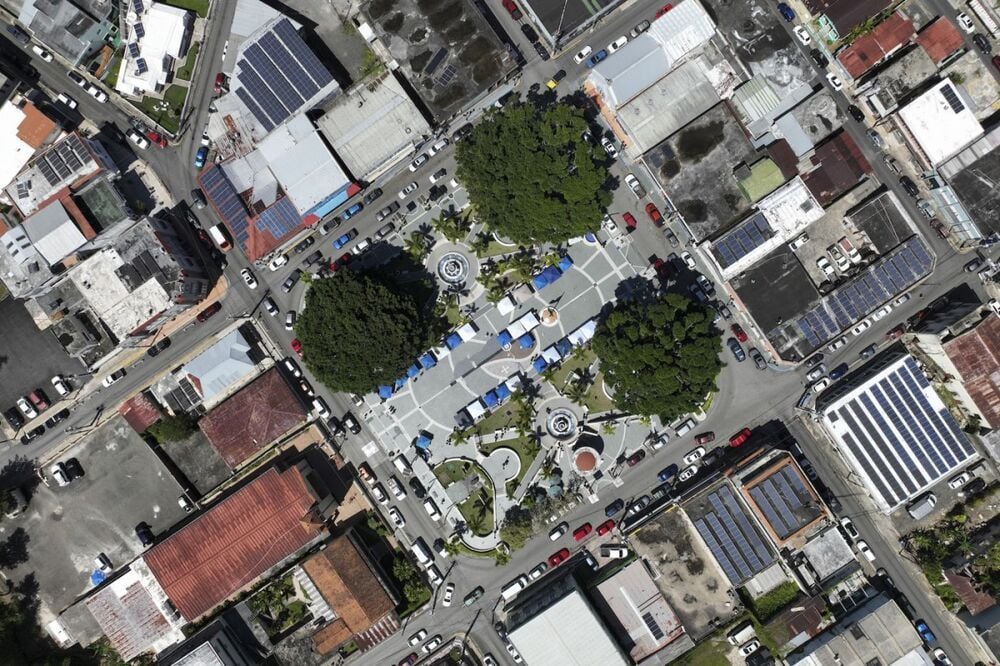
Nestled in the central mountains of Puerto Rico, Adjuntas is becoming a global model for its equitable transition to clean energy. (Photo by Ricardo Arduengo)
Irizarry had spent $15,000 on diesel in the six months he was without power after Maria. When the grid finally came back on, the cost of energy kept rising — electric bills were sucking up 30% of Lucy’s operating expenses. Meanwhile, a longstanding energy independence initiative was paying dividends while providing reliable power in his own backyard.
A few blocks from the pizza shop, dozens of Adjunteños gathered at another community refuge — this one powered by renewable energy. Environmental nonprofit Casa Pueblo installed their first solar panels in 1999 and retrofitted the system to be completely off-grid just months before the hurricane. Locals came to charge phones, run dialysis machines, and store medications in the center’s refrigerators. One neighbor came daily to administer her son’s asthma treatment.
Founded in 1980, Casa Pueblo is well known across the island and among the diaspora, who were sending aid, trying, in part, to make up for the inadequate federal response after the hurricane. Across the island, groups like the Casa Pueblo have relied on deep roots in the community to create local buy-in and lead an equitable transition to energy security.
“We told people, we don’t want money — send us solar lamps,” says Arturo Massol Deyá, who along with his father leads Casa Pueblo’s efforts in Adjuntas. For practical reasons, yes, and because he saw an opportunity to educate the community about solar energy.
And it worked. Locals started looking to Casa Pueblo for solutions, including business owners like Irizarry.
Spread across the roofs of seven buildings in town, the island’s first community-owned solar microgrid will be able to power businesses that provide essential services for the community: a pharmacy, a hardware store, a bakery and Irizarry’s pizza shop, among others.
The microgrids – comprising two half-megawatt battery storage systems connected to 700 solar panels – will be connected to the central grid. In the case of an outage, they can “island,” relying on their own generation and storage.
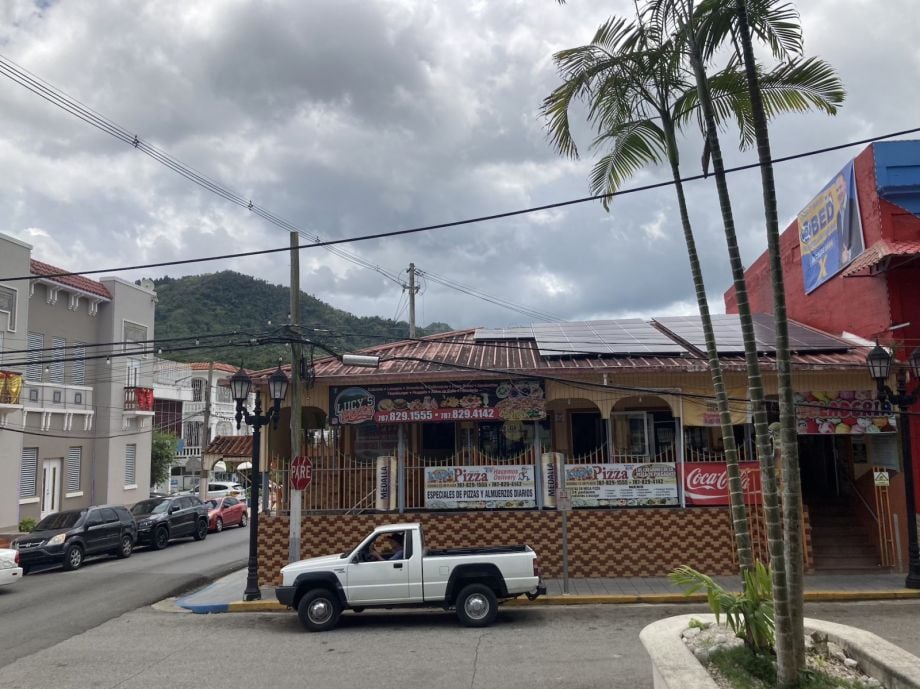
As a co-owner of the new solar microgrid, Lucy’s Pizza owner Gustavo Irizarry expects to save enough money on energy bills annually to hire two additional employees. (Photo by Katherine Rapin)
The systems will enable businesses to be energy oases during prolonged outages and pay — to the nonprofit the owners formed — a lower rate for energy year-round. Proceeds will be invested in solar projects for the community, starting with the homes of the most vulnerable residents.
The aim: building resilience in the face of increasing climate impacts, while generating wealth across Adjuntas.
The $2 million project was led by Casa Pueblo in partnership with the solar-energy focused Honnold Foundation and local business owners, and with the support of University of Puerto Rico Mayagüez, among others.
It’s the latest effort in Casa Pueblo’s “Energy Insurrection,” a movement to become an entirely solar-powered town and model energy resilience for communities across Puerto Rico.
“The microgrid is a major step in taking Puerto Rico from the vulnerability of the centralized fossil fuel system to the aspiration that I think we share in Puerto Rico,” says Arturo Massol Deyá. “To use local fuels and generate power at the point of consumption, where it’s needed.”
As storm-induced outages become more frequent, local generation and storage have become more critical, and not only on islands. The United States’ 700 microgrids, more than half of which were built since 2015, already provide reliable power for places like hospitals, schools and airports. By 2035, the Department of Energy expects microgrids will be “essential building blocks of the future electricity delivery system to support resilience, decarbonization, and affordability.”
With 350 residential and essential service buildings already running on solar and the town center set to be powered by two microgrids, Adjuntas has become a model for how a community can transition to solar power. Members of Congress like Nancy Pelosi and Alexandria Ocasio-Cortez have endorsed the solar movement in Adjuntas; in March, Secretary of Energy Jennifer Granholm met with leaders at Casa Pueblo to discuss strategies for Puerto Rico to completely transition to renewable energy by 2050.
“They’re leading by example, showing that 100% solar power is possible for Puerto Rico,” Granholm commented after her visit.
Leaders attribute their success to an approach that starts with bolstering solar education and access, relies on deep knowledge of the specific local needs, and builds wealth and resilience through community ownership of clean energy generation.
Despite $12 billion of federal funding allocated for rebuilding energy infrastructure since Hurricane Maria, Puerto Rico’s central grid is still in disrepair.
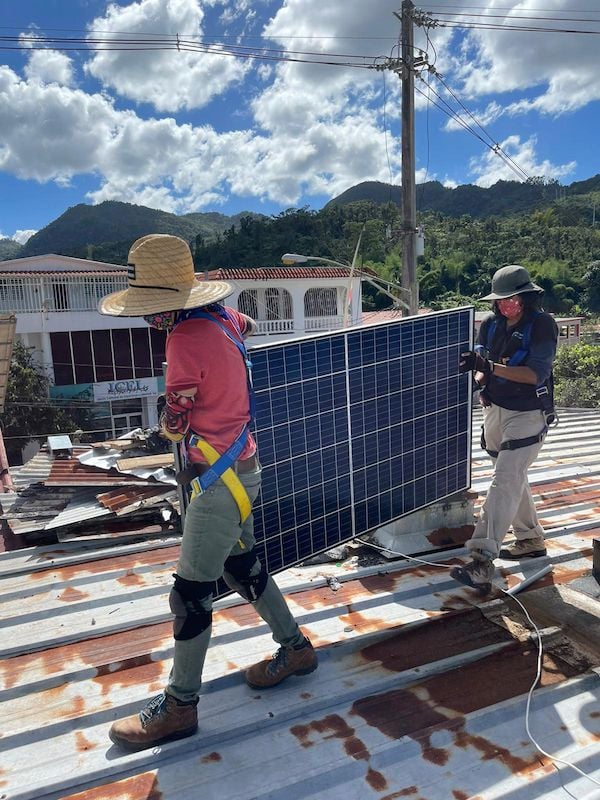
Puerto Rico-based Máximo Solar hired local women to help install the 700 solar panels that power the microgrid. (Photo courtesy of Casa Pueblo)
Outages after Fiona in 2022 exposed the persistent vulnerabilities of a system that’s reliant on imported fossil fuels, 32,000 miles of distribution lines and a public utility that’s $9 billion in debt. Since private American-Canadian company LUMA took over the island’s transmission and distribution in 2021, rates have increased more than seven times and blackouts have continued.
Puerto Ricans experience the consequences on a daily or weekly basis, while spending 8% of their income ($21,967, on average) on electricity, compared to 2.4% on the U.S mainland. To keep cool during increasingly frequent heat waves, islanders are using more energy — causing blackouts amid exceedingly dangerous temperatures.
Hundreds of renewable energy advocates, many represented by the movement Queremos Sol (We Want Sun), say the solution is obvious. Rooftop solar alone could potentially provide four times the island’s residential energy demand, Department of Energy studies have shown.
Despite efforts to transition to renewables and the local government’s goal of sourcing 100% renewable energy percent by 2050, the island currently sources less than 4% from renewables.
The utility Puerto Rico Electric Power Authority (PREPA) has instead advanced natural gas projects without federal regulatory approval and even proposed a fee on energy generated by rooftop solar to help restructure their debt. In April, a group of environmental non-profits sued FEMA, claiming that the federal agency’s plans to rebuild the grid “fail to meaningfully consider relying on distributed renewable energy systems.”
The Puerto Rico Energy Resilience Fund’s $1 billion, approved by Congress last year and managed by the U.S. DOE, isn’t expected to be allocated until the end of 2023. In the meantime, the DOE team is collecting input from community leaders like those at Casa Pueblo, who have been on the ground developing their own solutions for the past six years.
Since distributing 14,000 solar lamps after Maria, Casa Pueblo has built a public solar park and installed more than 350 solar systems on homes and essential service buildings.
Homes with solar are saving an average of $40 per month on energy bills, Casa Pueblo estimates, and were able to maintain power when Fiona hit last fall.
These ongoing projects have given locals the opportunity to see the benefits of solar energy firsthand and garnered support for the microgrid, which has been four years in the making.
In 2019, leaders at Casa Pueblo were considering the potential impacts of solarizing businesses in downtown Adjuntas — providing energy security in the heart of the community while disrupting the fossil fuel industry by unplugging those with the highest energy demands, as Massol Deyá saw it. Meanwhile, business owners like Izairry were looking for alternatives.
But as the microgrid idea was taking shape, Casa Pueblo’s late co-founder Tinti Deyá Diaz wasn’t totally on board; she wanted to ensure lower-income residents would continue to benefit from the solar transition.
Her concern led the 14 businesses owners who will receive power from the microgrid to form the nonprofit Asociación Comunitaria Energia Solar Adjuntas (Community Solar Energy Association of Adjuntas, or ACESA), essentially operating as an independent utility.
They’ll pay 25 cents per kWh to themselves, about 10 cents cheaper than what they’d pay the utility. After covering maintenance and operation costs, proceeds will be reinvested in community solar projects, prioritizing homes of the most vulnerable Adjunteños.
It’s a model many communities on the island are interested in replicating. Last October, Casa Pueblo organized a community meeting to bring together about 30 groups working on solar projects on the island. Attendees included folks working on a microgrid project in Maricao, a mountain town of about 5,000. They’re also aiming to solarize local businesses, including the town’s only bank, which doesn’t have a backup generator.
It hasn’t been easy to get some business owners to commit to a 20-year project (the approximate life of the panels and batteries), says Andrew Hermann, director of Monte Azul Foundation, which is spearheading the Maricao project.
When residents of the mountain town visited Casa Pueblo, “seeing [the microgrid] in person and talking to business owners that are super pro-microgrid — it’s really assuring the business owners here,” Hermann says. “That’s the type of energy that helps build these projects from the ground up.”
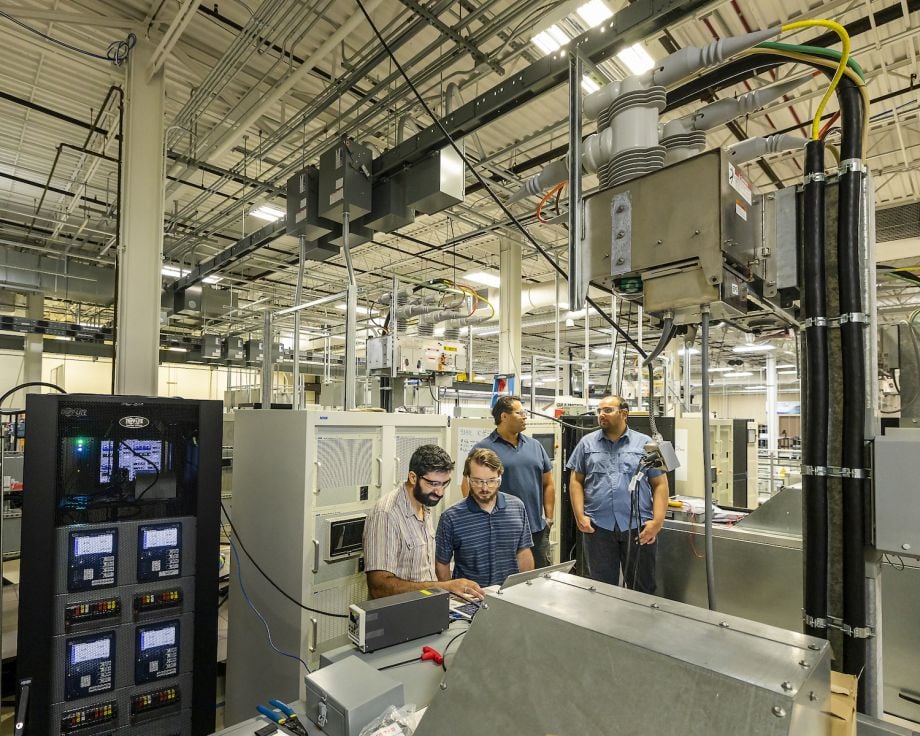
At the Department of Energy’s Oak Ridge National Laboratory, researchers are developing architecture and algorithms to make the Adjuntas microgrids more reliable and resilient. (Photo by Carlos Jones / U.S. Dept. of Energy / ORNL)
Adjuntas is also the site of microgrid resilience research by scientists at DOE’s Oak Ridge National Laboratory, in collaboration with University of Puerto Rico Mayaguez and other U.S. Universities.
“What happens if you lose 30-40% of the [power] generation in one solar array due to a hurricane?” says Maximiliano Ferrari, an engineer at the Oak Ridge lab and among the leaders of the research team.
The team is working to develop a technology to connect the two microgrids — which they call a “microgrid orchestrator” — enabling them to share energy if one is compromised. Referred to as networking or clustering, this nascent technology is expected by many in the industry to be an important component of future microgrids.
Ferrari says the project in Adjuntas is a perfect — and rare — testing site, because the microgrids are so close together. The team plans to start testing the microgrid orchestrator this summer. At the end of the project, all the developments will be open sourced, says Ferrari.
The project still faces the challenge of connecting to the central grid. Only time will tell how the goals of ACESA will play out in reality. Massol Deyá acknowledges mistakes along the way — for one, the project was costlier than it could have been.
“But it’s the first time; you have to do it to have that experience, and use that to help others,” says Massol Deyá. “We share what we have done — the challenges, the limitations, the complications.”
The developments in Adjuntas have already been put to the test with Hurricane Fiona.
A Category 1 storm when it hit in the fall of 2022, just days after the five-year anniversary of Maria, Fiona caused prolonged outages across the island. But in Adjuntas, the solar-powered fire station was able to respond to local needs and even intercept calls from the station in Ponce, 15 miles south, which had lost power. Casa Pueblo’s solar radio broadcast was uninterrupted; remote workers gathered at the solar park to plug in; many residents with medical conditions were able to continue treatments thanks to the panels on their roofs.
Hours after the storm, one family posted on Casa Pueblo’s social media thanking them for the solar system that allowed their daughter to continue her dialysis during and after the storm.
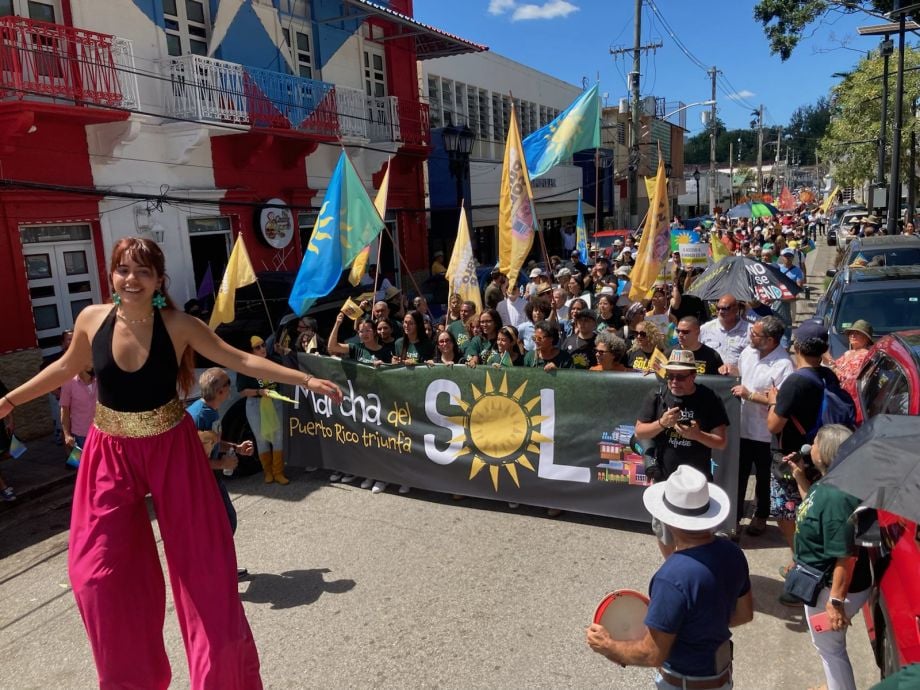
In March 2023, thousands lined the streets of Adjuntas for Casa Pueblo’s second annual rally for solar energy. (Photo by Katherine Rapin)
In March, thousands lined the streets of Adjuntas for Casa Pueblo’s Marcha del Sol to show support for solar energy and celebrate the completion of the microgrid.
“Energía so-lar — pa’ un mejor país!” they shouted. Solar energy, for a better country!
“When you see the entire landscape, you know that we are still at risk — we are going to be confronting the same climate change challenges, hurricanes, earthquakes,” says Massol Deyá. “But I can say, and it was tested with Fiona, that Adjuntas is in a better position to confront these realities.”
This article is co-published with Nexus Media News and made possible by a grant from the Open Society Foundations.

Katherine Rapin is a freelance climate journalist based in Puerto Rico. Her work has been published by WIRED, Yes! Magazine and Yale Environment 360 among others. She's currently focused on stories about climate adaptation, resilience and humans restoring relationships with the natural world.

20th Anniversary Solutions of the Year magazine